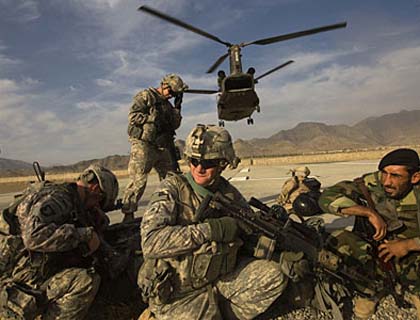KABUL - NATO officials in Brussels have endorsed a presence of 8,000 to 12,000 troops to remain in Afghanistan after the combat mission ends in December of 2014, reported the New York Times on Monday. The coalition was said to have modified previous plans for post-2014, minimizing its objectives.
There are currently around 100,000 foreign troops in Afghanistan, out of which around 68,000 are Americans. Two thirds of the residual force endorsed by NATO officials is expected to be U.S. soldiers.
The figures now being proposed by the coalition for post-2014 are substantially smaller than those suggested in the past. But according to the New York Times, senior alliance officials said that a larger presence would be unnecessary considering the more modest goals being pushed by politicians in supporting countries.
Despite military leaders and experts advocating for a larger residual presence in order to ensure Taliban insurgents do not roll-back hard fought progress from past years, political leaders in the U.S. and Europe have been resistant to the idea of dedicating what they consider unnecessary resources to continue a fight they have been in for twelve years.
According to an unnamed senior NATO diplomat that spoke to the U.S. newspaper, the nature of the coalition troop presence post-2014 was mostly predicated on what foreign officials thought was necessary to properly "administer, oversee and account for" the 4.1 billion USD of security assistance aid that has been allocated.
The primary role of the troops that stay behind is intended a withdrawn one. Coalition forces will ensure aid money is not wasted and misused, as well as leading what has been described as a "train, advise and assist" mission to support the Afghan security forces, but they are not expected to see much combat engagement.
Many Afghan officials and security experts have been worried in recent months about the fate of the Bilateral Security Agreement (BSA) between Washington and Kabul, which will detail the involvement of the U.S. in Afghan national security affairs post-2014. The BSA remains in question as President Hamid Karzai has deferred the decision on its most contentious provision – immunity for U.S. troops from criminal prosecution in Afghan courts – to a Loya Jirga set to be held in the coming weeks.
Nevertheless, Afghans responded to the implications of NATO's decision outlined in the New York Times report on Monday by challenging the idea that Afghan security institutions required close supervision in the use of assistance funds.
"With regard to financial cooperation to the Ministry of Interior and its expenses, there already exists a professional team here and they monitor the aid spending on their own," the Ministry of Interior's Deputy Spokesman Najibullah Danish told TOLOnews.
Some expressed offense at the prospect of international forces looking over the shoulders of Afghan security officials.
"I think it's an insult to say that international forces will monitor transparency in our security institutions," said Afghan military analyst Hilaluddin Hilal.
Nevertheless, the track record of aid money management in Afghanistan is not the best, and well-documented cases of corruption and waste have abounded over the years in security and non-security related institutions.
According to the New York Times report, the revised NATO plan for post-2014 would have troops largely stationed in Afghan military and police headquarters rather than dispersed around the country in strategic combat-related locations. The point being their role would be focused toward the monitoring of decision-making related to the use of aid money and support in the training of new Afghan recruits.
The Afghan security forces currently number around 350,000 men. Over the past year, they have assumed almost all operation responsibilities from coalition troops.
2013 was one of the most violent fighting season in Afghanistan since the war against the Taliban insurgency began in 2001. The Afghan forces saw record casualty numbers that many officials have said would be unsustainable in the future. (Tolo News)

